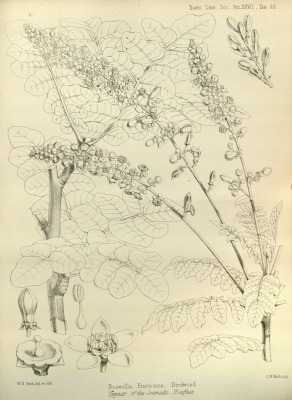Boswellia frereana
Birdw.
Burseraceae
Common Name: African Elemi
General Information
Boswellia frereana is a small evergreen tree growing up to 8 metres tall, though usually smaller.
The plant has a very long history of human use, with evidence to show it being employed by the ancient Egyptians over 3,500 years ago[
238- Title
- Encyclopaedia of Herbs and their Uses.
- Publication
-
- Author
- Bown. D.
- Publisher
- Dorling Kindersley, London.
- Year
- 1995
- ISBN
- 0-7513-020-31
- Description
- A very well presented and informative book on herbs from around the globe. Plenty in it for both the casual reader and the serious student. Just one main quibble is the silly way of having two separate entries for each plant.
]. It is often cultivated and harvested from the wild for its aromatic resin[
301- Title
- Cornucopia II
- Publication
-
- Author
- Facciola. S.
- Publisher
- Kampong Publications, California.
- Year
- 1998
- ISBN
- 0-9628087-2-5
- Description
- The second edition of an excellent guide to the edible uses of plants, though it does not give any details of cultivation etc.
].
Known Hazards
None known
Botanical References
Range
Northeastern Africa - Somalia.
Habitat
Not known
Properties
| Other Uses Rating |      |
| Habit | Evergreen Tree |
| Height | 8.00 m |
| Cultivation Status | Cultivated, Wild |
Cultivation Details
Not known
Edible Uses
None known
Medicinal
None known
Other Uses
A resin is obtained from the stem[
46- Title
- Dictionary of Economic Plants.
- Publication
-
- Author
- Uphof. J. C. Th.
- Publisher
- Weinheim
- Year
- 1959
- ISBN
- -
- Description
- An excellent and very comprehensive guide but it only gives very short descriptions of the uses without any details of how to utilize the plants. Not for the casual reader.
]. It is considered to be a superior form of frankincense[
46- Title
- Dictionary of Economic Plants.
- Publication
-
- Author
- Uphof. J. C. Th.
- Publisher
- Weinheim
- Year
- 1959
- ISBN
- -
- Description
- An excellent and very comprehensive guide but it only gives very short descriptions of the uses without any details of how to utilize the plants. Not for the casual reader.
]. Most resin is obtained by making deliberate incisions into the bark of the tree. The milky liquid that exudes hardens on exposure to air into droplets or 'tears' which are then easily detached by the collector. Occasionally, some tears are produced by accidental injury or from splits which occur in the stems or branches of the tree.
Propagation
Seed -
If you have any useful information about this plant, please leave a comment. Comments have to be approved before they are shown here.


 Useful Tropical Plants Database 2014 by
Ken Fern,
web interface by
Ajna Fern
with help from
Richard Morris.
Useful Tropical Plants Database 2014 by
Ken Fern,
web interface by
Ajna Fern
with help from
Richard Morris.